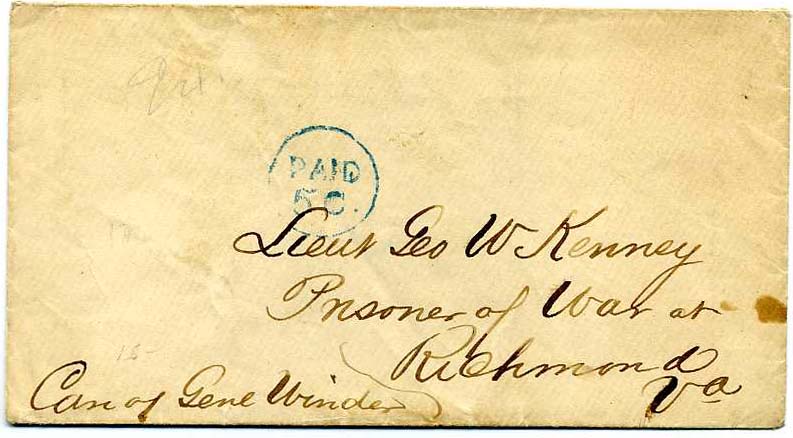-
Confederate Postal History
- CSA 1 on Cover, Section 1
- CSA 1 on Cover, Section 2
- CSA 2 on Cover
- CSA 3 on Cover
- CSA 4 on Cover
- CSA 5 on Cover
- CSA 6 on Cover
- CSA 7 on Cover Section 1
- CSA 7 on Cover Section 2
- CSA 8 on Cover
- CSA 9 on Cover
- CSA 10 on Cover
- CSA 11 on Cover Section 1
- CSA 11 on Cover Section 2
- CSA 11 on Cover Section 3
- CSA 12 on Cover Section 1
- CSA 12 on Cover Section 2
- CSA 12 on Cover Section 3
- CSA 13 on Cover
- Advertising and College Covers
- Blockade-Run Mail
- Confederate Patriotic Covers Section 1
- Confederate Patriotic Covers Section 2
- Independent State & US Used in Confederacy Section 1
- Independent State & US Used in Confederacy Section 2
- Miscellaneous Section 1
- Miscellaneous Section 2
- Mourning Covers
- Official Semi-Official and State Imprints Section 1
- Official Semi-Official and State Imprints Section 2
- Postmasters' Provisionals on Cover Section 1
- Postmasters' Provisionals on Cover Section 2
- Postmasters' Provisionals on Cover Section 3
- Prisoner of War & Cilvilian Flag of Truce Section 1
- Prisoner of War & Cilvilian Flag of Truce Section 2
- Prisoner of War & Cilvilian Flag of Truce Section 3
- Railroad Covers
- Sternes Correspondence
- Wallpaper Covers
- Confederate Stampless
-
Confederate Stamps
- Essays, Proofs, Private Printings
- Postmasters' Provisionals Section 1
- Postmasters' Provisionals Section 2
- Confederate Use of US Postage
- CSA 1 5 Cents Lithograph
- CSA 2 10 Cents Lithograph
- CSA 3 2 cents Lithograph
- CSA 4 5 cents Lithograph
- CSA 5 10 Cents Lithograph
- CSA 6 5 Cents Typograph
- CSA 7 5 Cents Typograph
- CSA 8 2 Cents Engraved
- CSA 9 10 Cents Engraved
- CSA 10 10 Cents Engraved
- CSA 11 10 Cents Engraved, Section 1
- CSA 11 10 Cents Engraved, Section 2
- CSA 12 10 Cents Engraved, Section 1
- CSA 12 10 Cents Engraved, Section 2
- CSA 13 20 Cents Engraved
- CSA 14 1 Cent Typograph
- Philatelic Literature
Navigate from drop-down boxes above or TABLE OF CONTENTS
In lot descriptions:
SCV = Scott Catalogue Value
CCV = 2012 CSA Catalog Value
Unused = no gum unless noted
Content anywhere underlined in blue is a clickable link - follow it
CSA Catalog vs. Scott Color Designation Chart
Click on thumbnails to enlarge
and see full item information
Please use Secure Interactive Order Form and carefully read the
Ordering and Sales Policies page before ordering.

Item# 12286
Price: $1,400
LIGON'S TOBACCO WAREHOUSE, RICHMOND VA: blue [Norfolk / Va.] PAID 5C. in circle on inner POW cover addressed to “Lieut. Geo. W. Kenney, Prisoner of War at Richmond, Va., Care of Genl. Winder” with light “Ex” examined marking at upper left. Southbound mail was directed to Fortress Monroe, from which it was transmitted to Norfolk where it would enter the Confederate postal system. A flag of truce letter was placed in an unsealed inner envelope (as offered here), then into an outer envelope with postage prepaid to the exchange point. There, the outer envelope was discarded, and the contents of the letter examined by military authorities. Confederate postage was then paid on the inner envelope, for delivery from the exchange point to destination. Because such mail was handled only by the postal system of the receiving side, inner envelopes show only Confederate markings. This is the scarce early Norfolk route. Mainly because of the relatively smaller prison populations, early mail from the September 1861 to May 1862 routed via Norfolk is much rarer than POW mail after 1862. Only 34 covers recorded in Harrison from Ligon's. [PA] [VA] $1,400.
Lieut. George W. Kenney of the California Regiment AKA 71st Penn. Infantry. Lt. Kenney was captured at Leesburg, Va. (Ball’s Bluff) October 21, 1861 and imprisoned in Richmond. But in November 1861, after part of the regiment had been badly handled in the debacle at Ball’s Bluff and their leader Col. Edward D. Baker was killed, the Keystone State adopted the California Regiment which was redesignated the 71st Pennsylvania Volunteer Infantry. Still, most of the men continued to refer to the regiment by its original name rather than its numerical appellation. Kenney, a 19 year-old former student, was killed June 30, 1862 at the Battle of White Oak Swamp during the Seven Days Battles in Virginia. There was an 1863 book written about him entitled A Model Soldier: a memoir of Lieut. George W. Kenney of the (1st California) 71st P.V. by Goldsmith Day Carrow based upon his letters home. Initially, the California Regiment was recognized by neither New York or Pennsylvania, but rather the Federal government. Indeed, its rolls were to be applied to the number of men to be called from the State of California.
